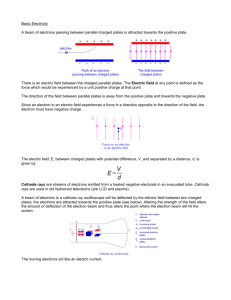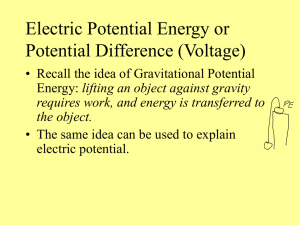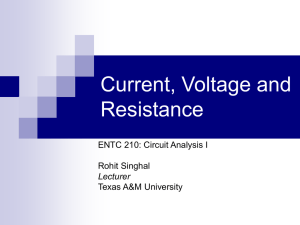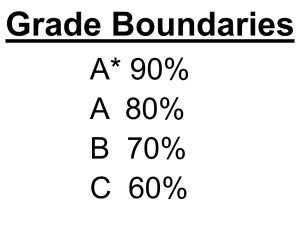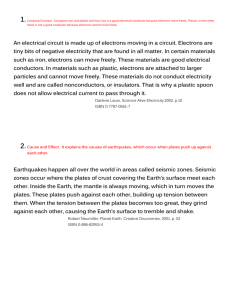Static Electricity Notes 2013
advertisement
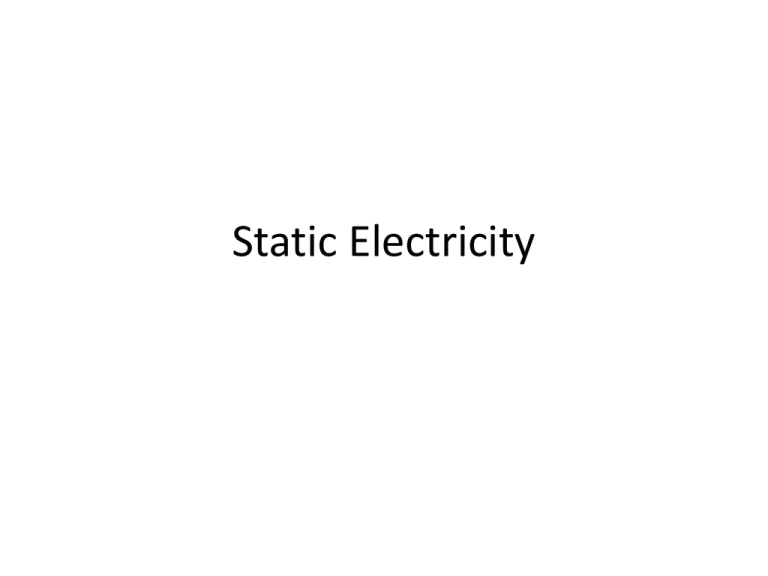
Static Electricity Understand the nature of electron charge and field lines. Success Criteria • Can identify the symbol for electric charge. • Can describe the accumulation of negative charge in terms of loss or gain of electrons. • Can recall the unit and symbol of electric charge. • Can recall the amount of electrons in one Coulomb. • Can work out the magnitude of a charge when given the number of electrons present. • Can draw the direction of field lines when given point charges. • Can identify a situation where a uniform field is present and one where a radial field is present Electric Charge • A positive electric charged is produced a point has lost electrons. • A negative charge is produced when there is a net gain in electrons. positive loses electrons + - + - + - + - + - + + - + - + + negative gains electrons + - - + - -+ - + + The Coulomb • The symbol for the quantity charge is q and it is measured in coulombs (C). • A charge (q) of -1.00 C is equal to the charge of 6.241 x 1018 electrons. • An electric charge can either be positive or negative. Exercise A balloon has a charge of - 3.50 μC. How many extra electrons are on the surface of the balloon? 6 3.5 C 3.5 10 C 6 3.5 10 C 1.0 C 6.241 10 18 2.18 10 electrons 13 When charging a ruler on a silk cloth 6.52 x 1011 electrons leave the ruler. What its charge? 6.52 10 11 6.241 10 7 18 9 1.04 10 C 104 10 C 104 nC Field lines • Point charges produce field lines. These field lines flow from a positive charge to a negative charge. - + + - Field lines • Draw the electric field lines present in the following situations. B A - + C - - + + Uniform Electric Field • Two parallel plates form an electric field separated by a distance, d and attached to a battery with a voltage, V produce a Uniform Electric Field, E. • At any point between the two plates the strength of the electric field, E acting on a charge is constant. At the edges the electric field is no longer uniform, it is radial. V=12V + + + + + E=2400Vm-1 + + d=5mm Can work out the strength of an electric field Success Criteria • Can define what electric field strength is. • Can solve electric field problems involving the voltage, electric field strength and distance between two plates. • Can describe how an electric charge can be used to work out the strength of an electric field. • Can explain why the direction of the force on an electron is opposite to the direction of the electric field. • Can work out the strength of an electric field when given the force and a charge. Electric Field Strength Electric field strength measure in Vm-1 or NC-1 E 1 d E V E V Voltage measured in V d distance measured in m For a constant voltage. The shorter the distance (d) between two the stronger the electric field(E). For plates kept at a constant distance. The larger the potential difference/voltage (V) the stronger the electric field(E). Example Exercises 1 What is the strength of an electric field produced when 15 V is applied across two plates separated by 4.0 mm? E V d 4.0mm 15V + + + + + + + 15V 0 .0 0 4 0 0 m -1 E=3750V m =3700V m -1 2 What is the distance between two plate that produce a 2000 Vm-1 electric field when 3.5V is applied. d V E 3.5V 2000 3 d= 1.75 10 m = 1.8m m 3 What voltage is needed to produce a 5200Vm-1 electric field between two plates 6.0mm apart? V E d= 5200V m V = 31.2= 31V 1 3 6.0 10 m + + + + + + + 4 If the voltage applied to two plates is kept constant what happens to the electric field strength if the two plates are pulled further apart? 1 •Since the voltage stays constant, E d •The distance increases. •The Electric field strength is inversely proportional to the distance so it (E) deceases. Force on a charge in an electric field F - F + + + + + + + + A positive charge has an electrostatic force acting on it in the direction of the electric field. This force, F is proportional to the charge, q of the particle and the strength of the electric field, E. The force acting on a negatively charged particle acts in the opposite direction to the electric field. Electric field strength measured in Vm-1 or NC-1 Force measured in N Charge measured in C FE F q If the charge is constant. If the electric field, E increases the force will increase proportionally. If the electric field, E is constant. The larger the charge, q the larger the force, F. Example Exercises 1 What is the force acting on a particle with a +9.23 nC charge place in between two plates with a uniform electric strength of 275 Vm-1? F E q 275V m 1 9 9.23 10 C 6 F= 2.54 10 N = 2.54 N q= +9.23 nC + + + + + + + E = 275 Vm-1 2 What is the strength of an electric field that applies a 24.5μN force to a particle with a charge of 300 nC?. d V E 3.5V 2000 3 d= 1.75 10 m = 1.8m m 3 If the electric field strength on a charge is doubled what happens to the electrostatic force the charge feels? •Since the charge stays constant, FE •The field strength increases. •The force is proportional to the electric field strength so it (F) increases. 4 What happens to the force on a charge in a uniform electric field if the distance between the two plates is halved? If we assume that the V stays constant, E ∝ 1/d ∴ when the distance halves, E doubles. If we also assume q stays constant, F ∝ E ∴ when the electric field strength doubles the force doubles. Define electric potential in terms of work and energy. Use V = work/q and V = ∆Ep/q to calculate change in electric potential energy Success Criteria • Can work out the change in potential energy using E p E qd • Recognise that when a charge does work(W) by moving against electric field lines it gains potential energy(∆Ep). • Recognise that when a charge moves with the field lines it loses potential energy and gains kinetic energy. E p • Can use V q to work out the potential energy a charge has • Can describe the relationship between work, Ek and Ep.

